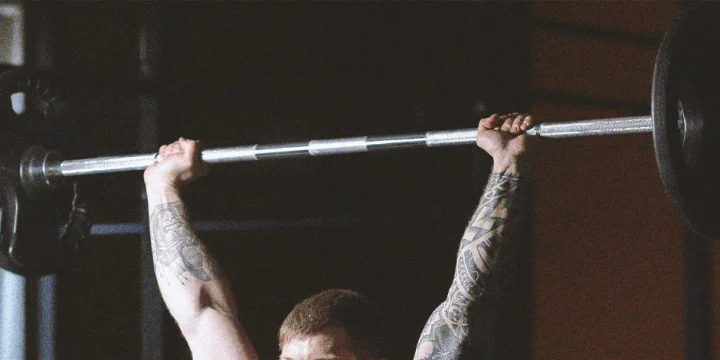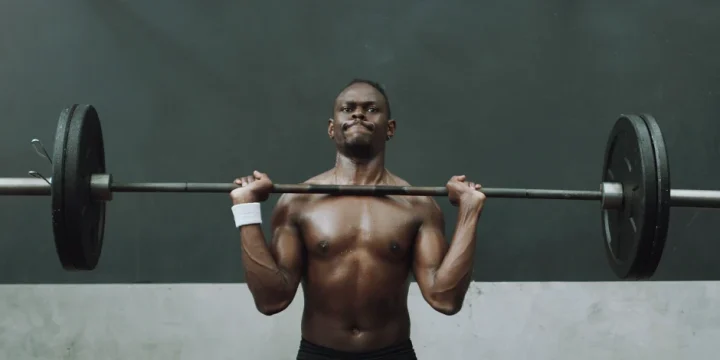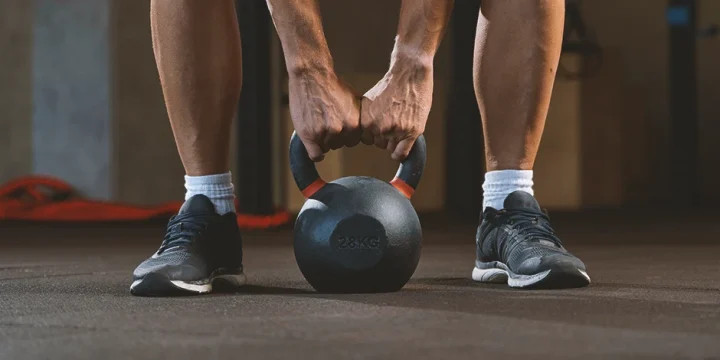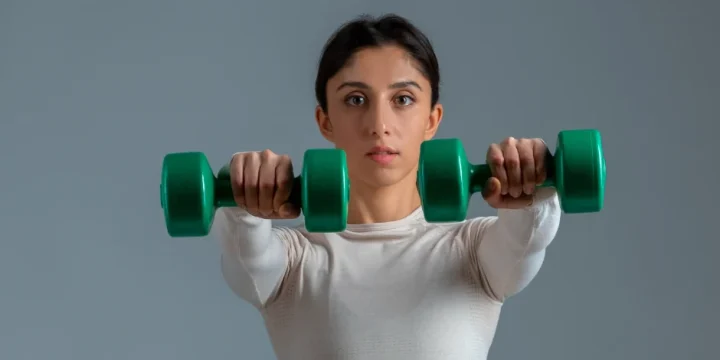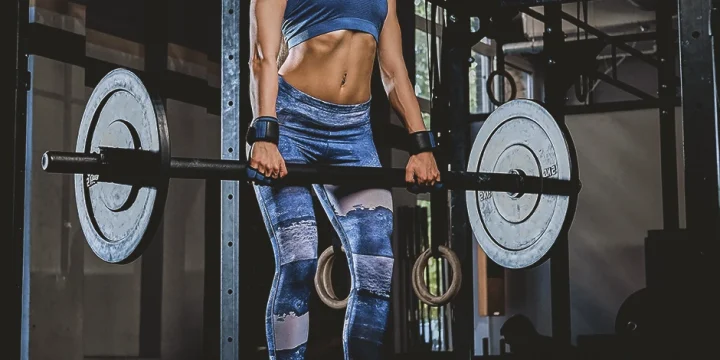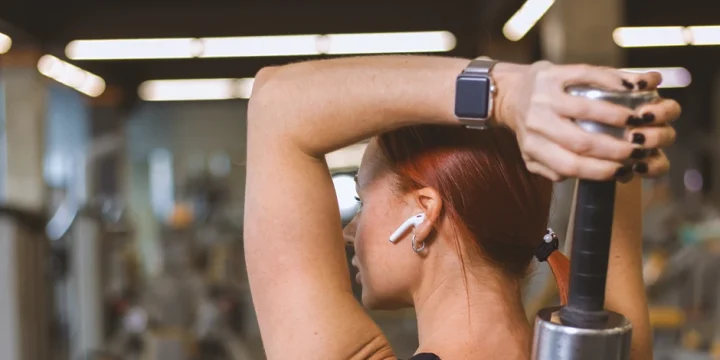Thinking about starting to overhead press is already a big step towards building insane feats of strength and hypertrophy, and this article promises to help you with that.
As a certified personal trainer, I coached many clients to perform overhead press techniques properly to maximize force production and minimize the chance of possible injury.
I took some time off to gather the best possible instructions, common mistakes, and best overhead press alternatives to ensure you get the most out of your learning phase.
After reading the article, you will be fully equipped to perform the technique of the barbell overhead press correctly and build your shoulder and upper chest muscles.
Quick Summary
- Learning how to overhead press is done through learning about the base, perfect stance, chin position, and head motion while pushing the barbell overhead.
- The most common mistakes while performing a standing overhead press include pressing around your head, gripping the bar too wide, and assuming a narrow stance with your feet.
- A study published on Research Gate recommends setting your hands on the bar wider than the shoulder width apart when doing the overhead press.
- In my experience, mastering the overhead press is a game-changer for serious strength training and overall upper-body development.
How to Do the Overhead Press

In my experience as a personal trainer, I've guided numerous clients through these steps, ensuring they perform the overhead press correctly and safely:
Step 1 — Set Your Base
Before even beginning to press overhead, the first step is to set the barbell on the J hooks of a durable squat or power rack.
The bar shoulder is at the level of your upper chest to unrack it easily.
Set your hands on the bar so they are wider than the shoulder width apart (change this based on your morphology) as recommended by studies published on Research Gate [1].
The barbell should sit in the meat of your hands or palms. Unrack the bar while keeping your wrists stacked over your elbows and elbows tucked in.
Step 2 — Find Your Stance
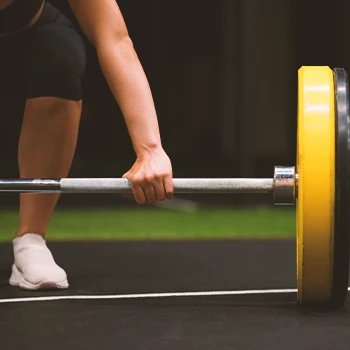
To find your stance, you first must take two steps back from the rack.
Set your feet about shoulder-width apart and grip the floor with your feet by pushing the knees out and twisting the feet outward.
This is all done without moving the feet at all. You must feel the tension in your legs. You can also feel free to play around with the initial stance until you decide you feel comfortable enough.
For instance, some weightlifters prefer to stand with their feet closer than usual.
Step 3 — Tuck the Chin and Brace
Before you start the pressing motion, you must contact your latissimus dorsi, brace the core, and tuck your chin.
We mainly do this because we can generate more force due to pressing from a stable base.
It is like making a shelf with your lats and taking a belly breath that fills your stomach with pressure (intra abdominal pressure).
Step 4 — Push Your Head Through
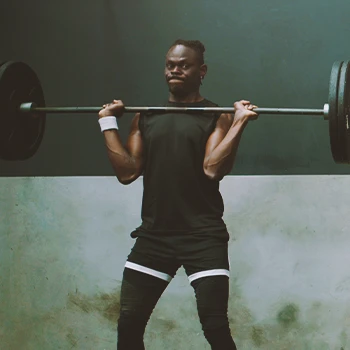
Start the exercise by pushing the barbell over your head and keep it positioned in the meat of your hands.
Drive it directly overhead. Contract your shoulders once the barbell passes the head and shrug so your head pushes "through" the bar.
The ideal position is where the barbell is positioned overhead in alignment with the heel and midfoot.
The last step is to lower the bar back to the starting position as fast as possible but with sufficient control. Don't just drop it on your collarbone and injure yourself.
Overhead Press Form 101
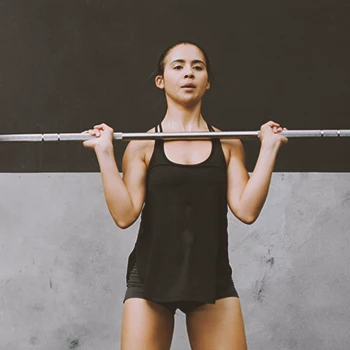
Throughout my career as a personal trainer, I've noticed that all overhead presses have multiple things in common, yet individual morphology greatly influences execution.
Smaller people prefer to grip the bar shoulder width, and people with wider shoulders prefer the wider pronated grip.
This is why you must never exactly copy someone's strict overhead press style.
Focus on the original and traditional techniques' basics and give your body freedom to adapt based on your bones and joint structure.
Here are some general things to keep in mind when overhead pressing:
- Stance - Your heels should be hip-width apart, feet flat on the floor, and pointing out slightly.
- Legs - Keep your hips and knees locked from beginning to end.
- Grip - Take a full grip, place the bare in the base of your palm, and close to your wrist while simultaneously squeezing it.
- Grip width - The grip should be narrow just outside your shoulder, and avoid using a wide bench press grip.
- Wrists - Never let your wrists bend backward extensively, or they will hurt.
- Elbows - From the side view, your elbows should be almost under the bar and about 45 degrees in the front without flaring.
- Forearms - Your forearms should be vertical from the floor from all angles.
- Upper arms - Your upper arms shouldn't be parallel to the floor since this isn't the front squat and must be vertical.
- Shoulders - The bar should be rested on your front shoulder muscles, and don't forget to shrug your shoulders to the ceiling.
- Chest - You must lift your chest by arching your thoracic spine inwards and aim to touch your chin with the upper chest.
- Upper-back - To lift your chest, slightly arch the thoracic spine, and don't squeeze your shoulder blades.
- Traps - Shrug your traps at the top and perform shoulder elevation at the top portion of the movement.
- Head - Your head should be kept neutral, looking forward.
- Lower back - Keep your lumbar spine in the physiological position (physiological lordosis) and avoid over-arching since that will likely result in injury.
- Torso - You should lean slightly back at the bottom, move forward at the top, and never over-arch your lower back.
- Way up - You should press the bar in the vertical line and stay as close to the bar as possible.
- Lockout - You must hold the bar over your shoulders and at the top portion of the movement to forget to elevate them towards the ceiling.
- Way down - Control the lowering phase of the bar to your shoulders, and keep lowering it without flaring your elbows.
- Breathing - Before you press, perform an inhale, and as you push the barbell over your head, perform an exhale with the help of your diaphragm.
- Bar path - The bar should be pressed vertically in a line over your head.
- Between reps - Perform another inhale, raise your chest, put your forearm vertically, and press again.
"Whether you’re a powerlifter, strongman, weightlifter, a CrossFitter, or bodybuilder, you know about the big three — the bench press, deadlift, and squat. There is, however, one more movement that you should consider a must-do — the overhead press."
- Jake Boly, Certified Personal Trainer
Overhead Press Variations

Here are some overhead press variations to modify your workouts and increase your strength and hypertrophy.
Dumbbell Overhead Press
Dumbbell overhead press is a barbell overhead press variation that involves additional work and activation from scapular, shoulder, and clavicular stabilizers to perform the movement.
The design of dumbbells requires your body to use different stabilizer muscles to stabilize the overhead pressing motion.
The muscles that work during the exercise are the same as for the military press.
Related: Best Dumbbell Exercises: Workout Routine to Build Muscle
Seated Overhead Press
You can perform the seated overhead press with barbells and dumbbells, depending on your goals and choice.
The seated position will turn off additional stabilizer muscles and allow you to exert more strength and spend less energy balancing your body.
Shoulder Pin Press
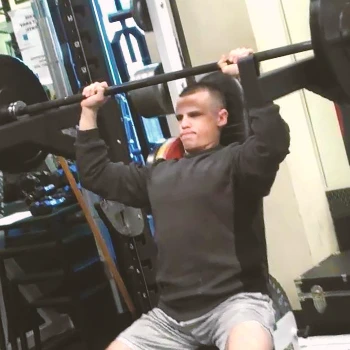
The shoulder pin press takes the bottom position out of the equation by allowing the barbell to rest on the squat pins.
This is excellent if you want to avoid losing extensive energy between the eccentric and concentric phases.
However, I wouldn’t recommend it for beginners since you want to exercise shoulder and chest to develop all muscle fibers holistically before experimenting with additional pressing variations.
This is also true for other overhead press alternatives such as push press, landmine shoulder press, and Z press.
Related: 30-Minute Shoulder Workout
Alongside these variations, it's beneficial to consider nutritional guidelines that complement overhead press training.
For instance, a diet rich in protein and balanced in carbohydrates and fats can significantly enhance muscle growth and recovery.
Muscles Worked by the Overhead Press

From my experience in training clients, the overhead press is a fantastic upper-body strength exercise that engages multiple muscle groups.
It primarily targets the upper pectoral major, anterior and lateral deltoid heads, and triceps brachii.
A wider grip increases activation in the lateral deltoid and pectoral muscles, while a narrower grip focuses more on the triceps brachii and anterior deltoid.
This exercise, part of the vertical push movement pattern, synergistically utilizes nearly all pushing muscles.
"It is often impressive to see a lifter pressing huge weights overhead (with good form), and should be a place of pride. The overhead press is a foundational compound movement that is great for building the upper body and a test of upper body stability."
- Chane McLean, Certified Personal Trainer
Common Overhead Press Mistakes

In my years of coaching, I've seen many clients make mistakes while performing the overhead press. It's crucial to address these errors promptly to prevent injuries.
Pressing Around the Head
Gripping the Bar Too Wide
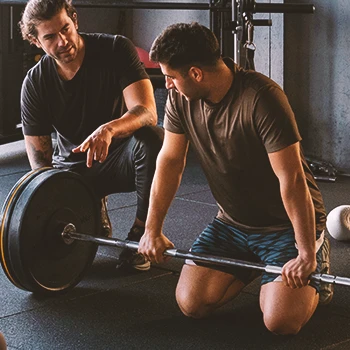
The second mistake a lifter can make is taking the wrong width of the grip.
Most commonly, the lifters grip the barbell too wide.
This can significantly reduce your power output because you are taking the prime movers and putting them in an unfavorable position.
One of the rules you can follow to avoid this mistake is to keep your forearms perpendicular to the barbell when you are in the middle of the pressing motion.
Related: Exercises to Build a Powerful Grip Strength
Assuming a Narrow Stance
The third mistake is assuming a narrower standard than usual, often resulting in an immediate loss of stability and balance.
When you lose balance and stability, you start shifting your body to compensate for the additional movements, resulting in unpredictable muscle activation and potential injuries.
You should feel free to play around with your initial stance, but remember that stability and balance are among the most important factors when performing a military press to avoid injury.
Related articles:
FAQs
Is Overhead Press Good for Beginners?
Yes, the overhead press is good for beginners. Almost every exercise you can think of can be performed by a beginner but in a controlled environment with less weight and a trainer’s assistance.
Why Is Overhead Press So Difficult?
The overhead press is so difficult because it biomechanically requires cooperation from multiple joints and muscles, which is often neglected in lifting programs. Also, the overhead press movement involves work from the other shoulder, clavicular and scapular stabilizers, which are often weak.
How Much Should a Man Be Able to Overhead Press?
A man should be able to overhead press at anywhere from 0.5 to 0.8 in his body weight. This is achievable through a strength training program lasting at least two mesocycles and containing both the accumulation and transformation phases.
References:
- www.researchgate.net/publication/319607633
- https://www.ncbi.nlm.nih.gov/pmc/articles/PMC9781216/
About The Author
You May Also Like
